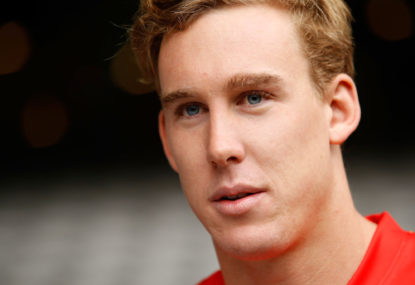Today’s installment of my offseason list breakdown and trade period preview series looks at the sick man of the AFL, the Gold Coast Suns.
It’s clear that the Suns have a myriad range of problems and, while there’s plenty of high draft picks on the list, it’s still very much a work in progress.
List breakdown
Gold Coast entered 2018 as a popular pick to win the wooden spoon, and this comes as no surprise if you look at where their list was at.
They were the youngest list on average at just slightly older than 23 years, and in the bottom three along with St Kilda and North Melbourne for average experience.
The Suns decided to lean into the skid, pumping the vast majority of their games into their young players no doubt in the hopes of accelerating their development.
The selection committee gave 51 per cent of all games to players aged 23 and under, significantly more than the league average of 38 and the third most of any club.
Unfortunately for the Suns, if they were hoping that this investment in youth would result in displays of match-winning talent, it did not.
Their players 23-and-under attracted only 45 AFLCA votes for the year, well down on the league average of 71 for this age group.
It was the worst result of any club to be investing at least 50 per cent of games into players under 23, and 13th overall.
The better performers in this group were those who are close to ageing out of it – Touk Miller, Nick Holman and Lachie Weller. None set the world on fire, but they were solid.

(AAP Image/Dave Hunt)
Jack Martin and Peter Wright are also in this group but both had difficult years, only managing 22 games between them.
You’ll also find here Brayden Fiorini, Callum Ah Chee, Jack Bowes, Ben Ainsworth, Will Brodie, Jack Scrimshaw and Wil Powell, who’ve played varying amounts of games and showed at least some talent.
There’s a lot of high draft picks in this age group, but the voting numbers suggest they aren’t living up to expectations yet.
Whether or not they ever will – and whether it will be at this club if they do – remains to be seen.
The strongest area of Gold Coast’s list in 2016 was undoubtedly its prime-age players, composed mostly of those drafted to the club in its opening years, and a few who’ve been traded in since.
David Swallow, Tom J Lynch, Steven May, Rory Thompson and Alex Sexton are in the first category, Jarrod Witts, Jarryd Lyons and Aaron Young in the latter.
Together this group of players account for more than half of the Suns’ total of 132 coaches votes, though it should be noted that this was the worst total haul of any club in the league.
They represent a prime-age group that is probably close to par against the league average, but is at risk of collapsing entirely due to player departure.
We already know that Lynch won’t play another game in red and gold, and there’s a risk that the captain abandoning ship leads to a few others jumping off as well.
The Suns have no doubt gone to both Steven May and David Swallow with the idea of signing them up to be long term leaders of the club, but may have gotten the opposite result.
For Swallow, there are mixed signs – while he’s publicly spoken positively about re-signing, pen certainly has not yet been put to paper, and there’s been talk in the media of him heading in the opposite direction.
History suggests that probably both sides of the story deserve some degree of scepticism. On one hand Swallow has shown an admirable level of loyalty in the past, on the other I think even the most romantic of footy fans could understand if that was starting to wear a little thin.
May seems a little more swung towards leaving than staying – he’s said he doesn’t want to go this year, but it’d be something he’d have to consider if the club want to move him on.
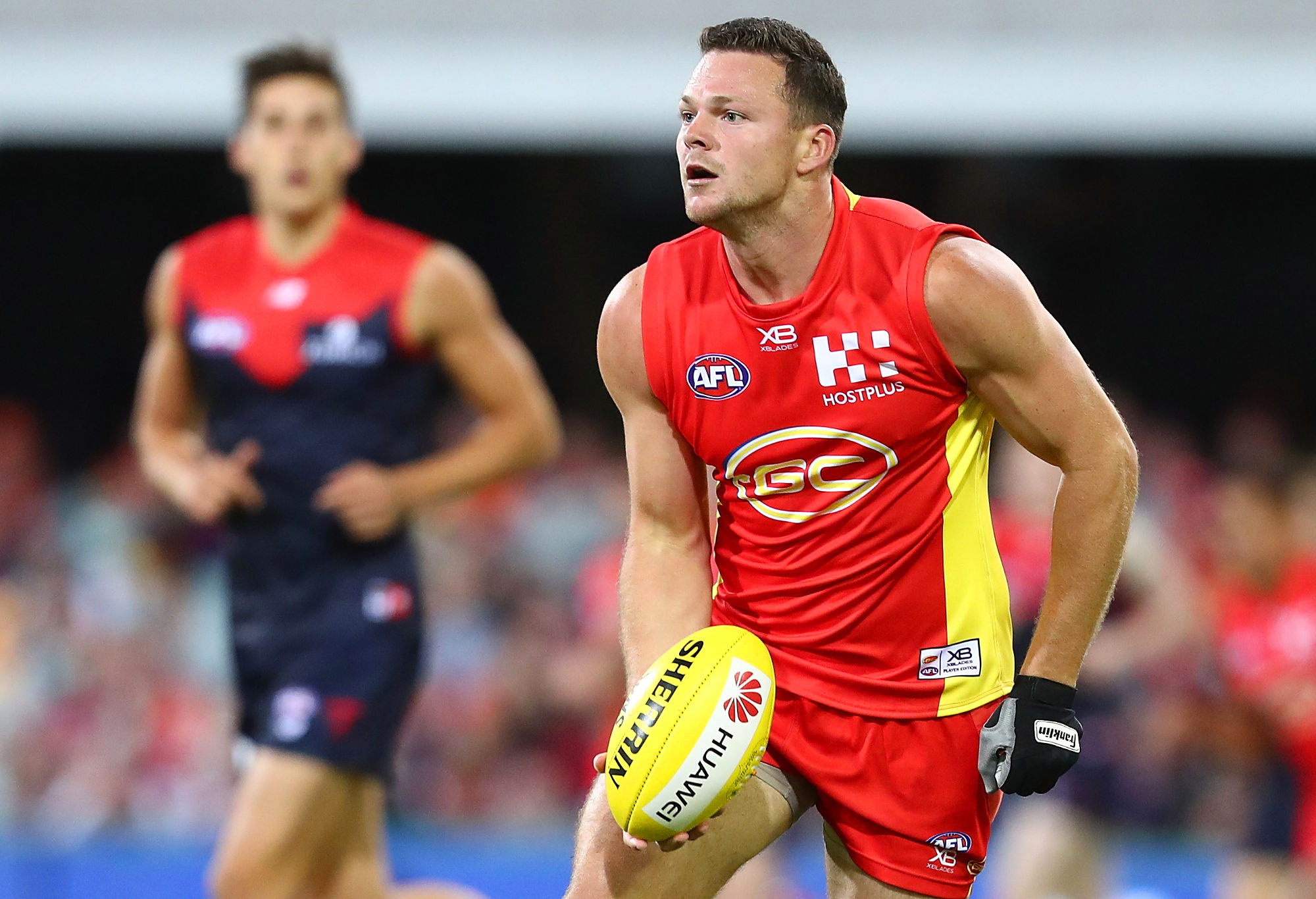
(Photo by Chris Hyde/Getty Images)
Lynch clearly feels – and perhaps Swallow and May would too – that after giving so much of their careers to this club for little reward, they’ve earned the right to choose where they play. They wouldn’t be not wrong to do so.
But if they all leave over this year and the next, while it will give the Suns more resources to invest into the draft, it will rob this prime-age group of their most important talent and set the club back at least three years.
Worse yet, it seems hard to stop – the culture rot at the club has probably already set in too deep. And one of the reasons for that no doubt is the lack of quality veterans at the club
Jarrod Harbrow, Pearce Hanley, Michael Barlow, Matt Rosa and Michael Rischitelli make up the Suns ’30-and-over’ group, but Harbrow’s 12 votes for the year were the only ones they picked up.
The leaguewide average in 48 votes from players 30 and over, and only Collingwood, St Kilda and the Western Bulldogs recorded less votes from players in this age group.
There was a week during the year when, coincidentally enough, Harbrow and GWS’ Callan Ward both became the first players to play 150 games for their respective clubs.
Everyone acknowledges the quality of leader that Callan Ward is and how his presence from day one has shaped the Giants’s culture – compare that to the minimal impact Harbrow has had at Gold Coast and you get a good idea of why one club is succeeding and one isn’t.
In retrospect the Suns clearly went down the wrong path in their early recruiting days – they landed a big fish in Ablett but surrounded him with players who ultimately have achieved little.
At GWS, young leaders like Callan Ward and Phil Davis certainly didn’t have the flash and marketability of Gary Ablett – but look where they are now, and look where Ablett is.
An absolute must for the Suns is to find some veteran talent from opposition clubs who come in and help shape their culture.
They tried to acheive this with Luke Hodge last year, but he ultimately joined an old friend Chris Fagan at the Lions instead. They must try again, harder, in 2018.
Underperformed or overperformed?
Gold Coast’s average team during the 2018 season was just slightly younger than 24 years old, and ultimately more than a full year younger than the league average.
They fielded the second youngest team on average of any club in the competition, behind only the incredibly baby-faced Western Bulldogs.
On average they fielded teams with a collective 1627.14 games experience – more than 400 games of experience below the AFL average.
Again, they were second last in this category, ahead only of the Bulldogs.
They ultimately picked up four wins, recorded a percentage of 59.9, and finished in 17th place.
Verdict: About even. Over the length of the season they probably underperformed, but they pinched enough wins to balance it out. On the ladder they finished exactly where their average age and experience suggests they should.
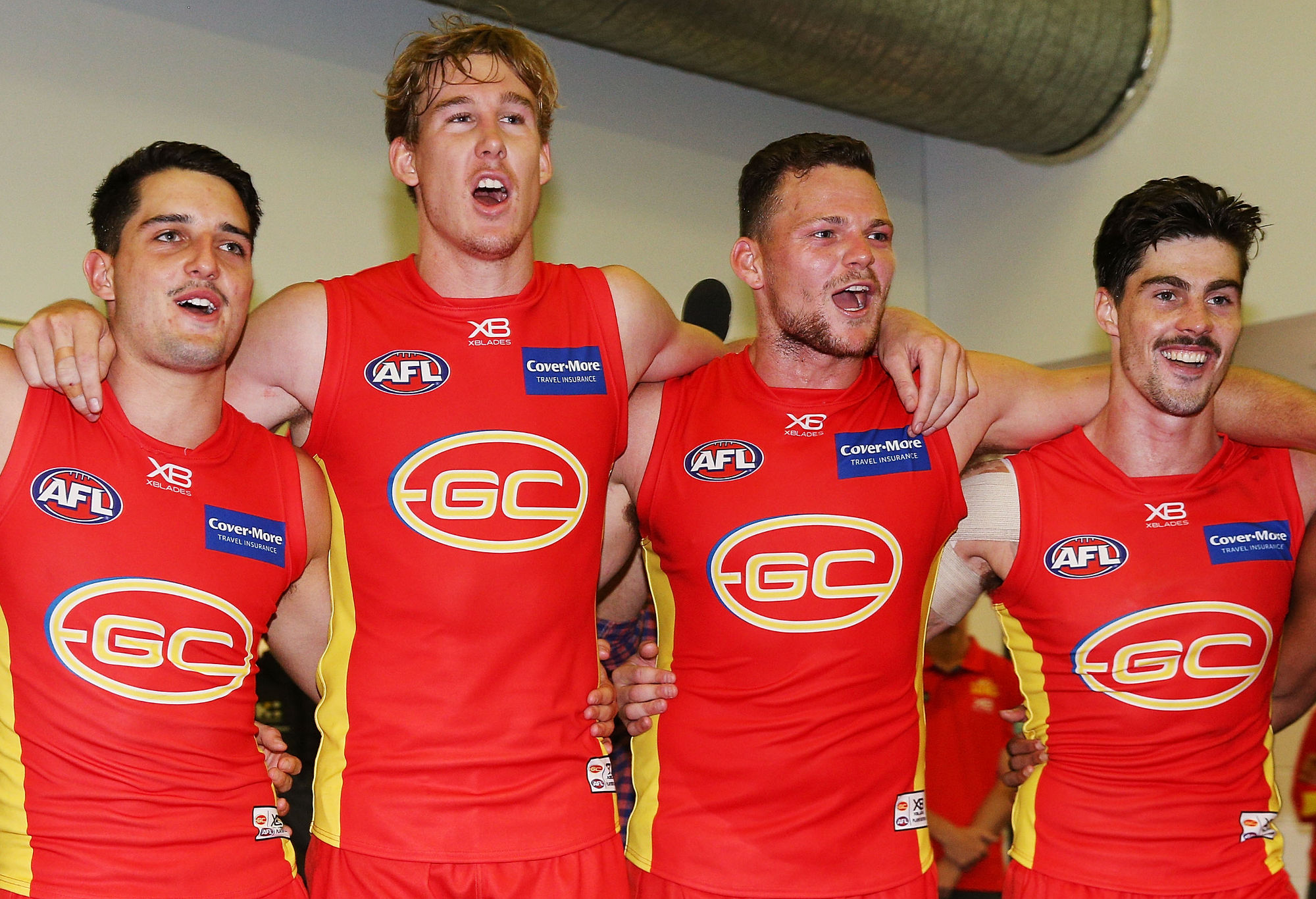
(Photo by Michael Dodge/Getty Images)
Contracts
Gold Coast’s contract list goes in the opposite direction to how any well-managed club’s ought to, and clearly shows the signs of a club with a player retention problem.
Many crucial players are all either coming out of contract this year – Kade Kolodjashnij, Tom J Lynch – or next – Callum Ah Chee, Jack Martin, Steven May, Touk Miller, David Swallow, Peter Wright.
Meanwhile, those locked in for the longest are average or unproven players who really out to be sweating on their security more than they will be – Charlie Ballard, Sean Lemmens, Wil Powell and Lachie Weller.
It’s not that having these players signed up for the future is a bad thing, but one can’t help but feel like – with the exception of Weller – that’s happened because these players wouldn’t be attracting offers elsewhere.
I guess when life gives you Sean Lemmens, you make Lemmens-ade.
Overall it’s clear that the Suns have a mountain to climb over the next two years. The first priority, if they can, should be to hold onto their prime-age players and keep this a strong group.
This would require them not only to convince Steven May and David Swallow to stay on, but they’d probably also need to bring in one or two quality players in this age bracket.
We’ll talk later on about how they could do that, but suffice to say that it’s probably not a super realistic scenario.
Instead what’s more likely is that the Suns will probably have to concede a lot of their prime-age talent is going to be lost, and instead focus on securing the 23-and-under group.
In terms of 2019 contracts, this means signing up Ah Chee, Martin, Miller and Wright as their top priorities.

(AAP Image/Joe Castro)
It also means convincing the likes of Will Brodie and Jack Scrimshaw – who’ve both been rumoured to want out – that they should stay and see out their contracts, which expire at the end of 2020.
2021
Charlie Ballard
Sean Lemmens
Wil Powell
Lachie Weller
2020
Ben Ainsworth
Jack Bowes
Will Brodie
Brayden Fiorini
Darcy Macpherson
Jesse Joyce
Joshua Schoenfeld
Jack Scrimshaw
2019
Callum Ah Chee
Brayden Crossley
Sam Day
Pearce Hanley
Nick Holman
Jack Martin
Steven May
Touk Miller
Tom Nicholls
Connor Nutting
Brad Scheer
Alex Sexton
David Swallow
Rory Thompson
Peter Wright
Out of contract
Michael Barlow
Jacob Dawson
Aaron Hall
Jarrod Harbrow
Jacob Heron
Josh Jaska
Kade Kolodjashnij
Jack Leslie
Jesse Lonergan
Tom J Lynch
Michael Rischitelli
Matt Rosa
Max Spencer
Mackenzie Willis
Unconfirmed
Jarryd Lyons
Harrison Wigg
Jarrod Witts
Aaron Young
Free agency
The headline act on the free agents list all year has been Tom J Lynch, and unfortunately for the Suns, we know with absolute certainty that he’ll be returning to Victoria at the end of the year.
That leaves the Suns with two options: they can either match the bid made for him by his club of choice and force a trade, or let him go and receive a compensation pick.

(Photo by Michael Dodge/Getty Images)
The unanimous opinion of those in the know is that Lynch will be joining Richmond – although nothing’s been formally announced just yet – so let’s look at it through that lens.
If Gold Coast force a trade they’d no doubt be hoping that they could acquire a pick and a quality player from the Tigers.
But, much like the Jaeger O’Meara deal two years ago, there just won’t be a quality player who wants to come.
More realistically what they could probably get is Richmond’s first pick this year, and their first pick next year – likely both late-teens picks.
Alternatively, if they let Lynch go freely, then they’ll certainly get a pick after their first pick this year, which will give them picks 2 and 3.
Although this year’s draft has been talked up as a ‘superdraft’, it really isn’t. It doesn’t have exceptional depth, but what it does have is a very strong top five or six players.
I’d say there’s five players in the draft who would all be in the mix for pick 1 if they were placed in just about any recent draft pool.
That being the case, it really is a slam dunk decision to decline to match the bid, and get two bites at the cherry in this year’s top five. Seeya, Tom.
Jarrod Harbrow and Michael Rischitelli are also on the Suns’ free agency list – you’d expect they’ll either sign on for 2019 or retire.
In terms of free agents coming in the other way, Gold Coast have been linked to a few – in particular Mitch Wallis, George Horlin-Smith, and Jarrad McVeigh.
This might not be a great path to go down for the Swans though as, technically, signing a free agent of their own could risk reducing or voiding entirely their compensation for Lynch.
The AFL knows how much they need it and would probably be willing to fudge the numbers a little so long as the Suns don’t sign anyone too big – or might direct them to trade for the player instead.
Horlin-Smith strikes me as the classic Gold Coast recruit – pick a player who doesn’t get opportunities at his current club, finally give him a solid run, and he’ll show you that he’s a passable footballer.
It’s been a relatively successful move with the like of Jarrod Witts, Jarryd Lyons and Aaron Young, but the fact they’ve had so much success doing this is really just an indictment of where the list is at.
Suffice to say that if the cornerstone of your side is blokes who weren’t good enough to make it at other teams, you will be not as good as those other teams.
Mitch Wallis is at a higher level of quality than this, albeit not much. He’d be an okay addition, but is probably the one most likely to impact on the Lynch compensation.
It’s probably too late to also go after someone like Luke Dahlhaus, but he’d be in a simillar boat to Wallis – worth getting, if you can.
Jarrad McVeigh on the other hand is the gold-star, thumbs up, foot down, absolute must-get-if-they-can player for the Gold Coast Suns this offseason.
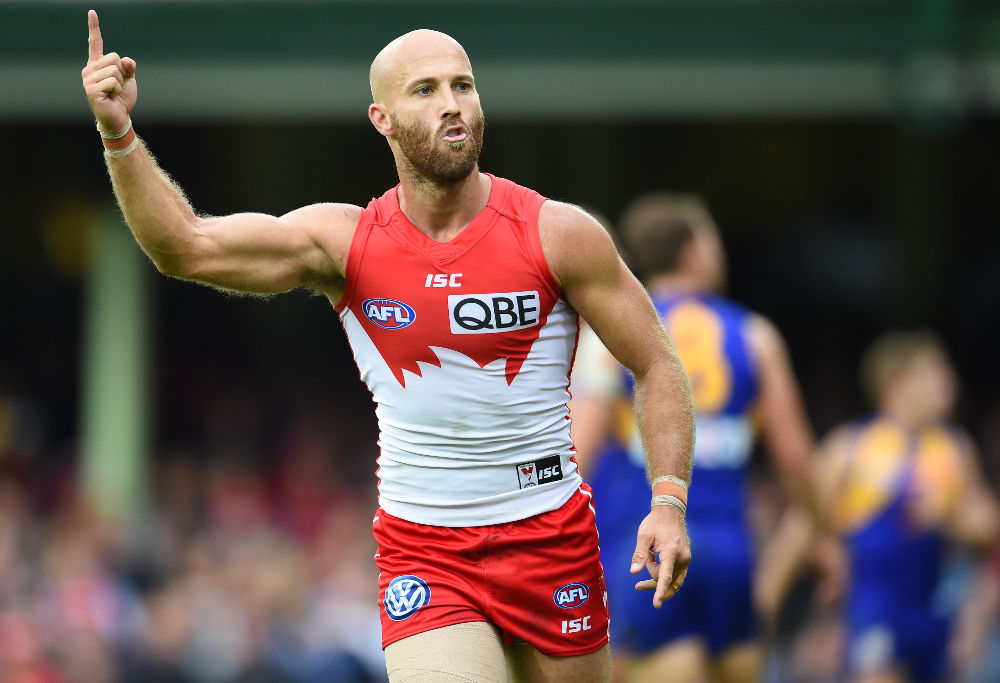
(AAP Image/Dean Lewins)
Let’s face it: the Suns don’t have much reason for players to want to come to them. For most players, it’ll just be the chance to make more money than anyone else.
Their only other assets when it comes to selling themselves to players is Stuart Dew’s pre-existing relationship with a lot of Sydney players, and the lure of being able to mentor and develop and young group (with the potential to transition into coaching).
Gold Coast must wield what little weapons they have to maximum advantage, and the player who best fits the bill is McVeigh.
John Longmire has said the plan is for him to retire, McVeigh has said he wants to play on – Gold Coast must offer him an inflated amount of dollars to come play for one or two years then join the coaching staff. Who else are you going to spend it on? Sean Lemmens?
McVeigh is Gold Coast’s best chance of landing a culture-leading veteran. However if they don’t get him – or even if they do, but want more, which isn’t a bad idea – I’d also be looking at Shaun Grigg, Bachar Houli and Paul Puopolo.
Trade period
The Suns have a reasonable group of prime-age players but are losing Tom J Lynch from it and risk the whole thing collapsing if David Swallow and Steven May leave as well. How do they prevent this?
Their best chance is to bring in multiple quality players in this age bracket and hope that the additions see the club’s form and culture improve and convinces them to commit longterm.
It’s going to be really difficult to pull off but if the Suns are going to have a chance, I believe the path to go down is again to maximise the value of Dew’s history with Sydney players.
The Suns clearly have an inkling of this already – they’re known to be in the market for out-of-contract defender Jake Lloyd already, who just yesterday was nominated in the All Australian squad.
However given he looks to be on the move, I think Suns – if they want to go down this path – out to come hard with a big offer for Sydney’s Dan Hannebery.
Most the talk is that Hannebery is likely going to be at St Kilda next year, but if there’s even a skerrick of a chance the Suns could convince him to move North instead, they must go for it.
They’d have the Dew-factor over the Saints and while St Kilda have probably but a fairly generous contract in front of him already, Gold Coast can probably afford to top it – especially if the AFL throws in some ambassador money.
In this scenario the Suns could offer pick 3 in the draft (received as compensation for Tom Lynch) to Sydney in exchange for Hannebery, Lloyd and McVeigh.
Yes, it’d mean giving up the chance to bring in an elite youngster, but they’ll still have a top-two selection up their sleeve, and it’ll be worth it to bring these players in.
Look, I know it’s a unrealistic – but if the Suns want to save their prime-age group, I think it’s probably the most plausible of a serious of likely implausible scenarios.
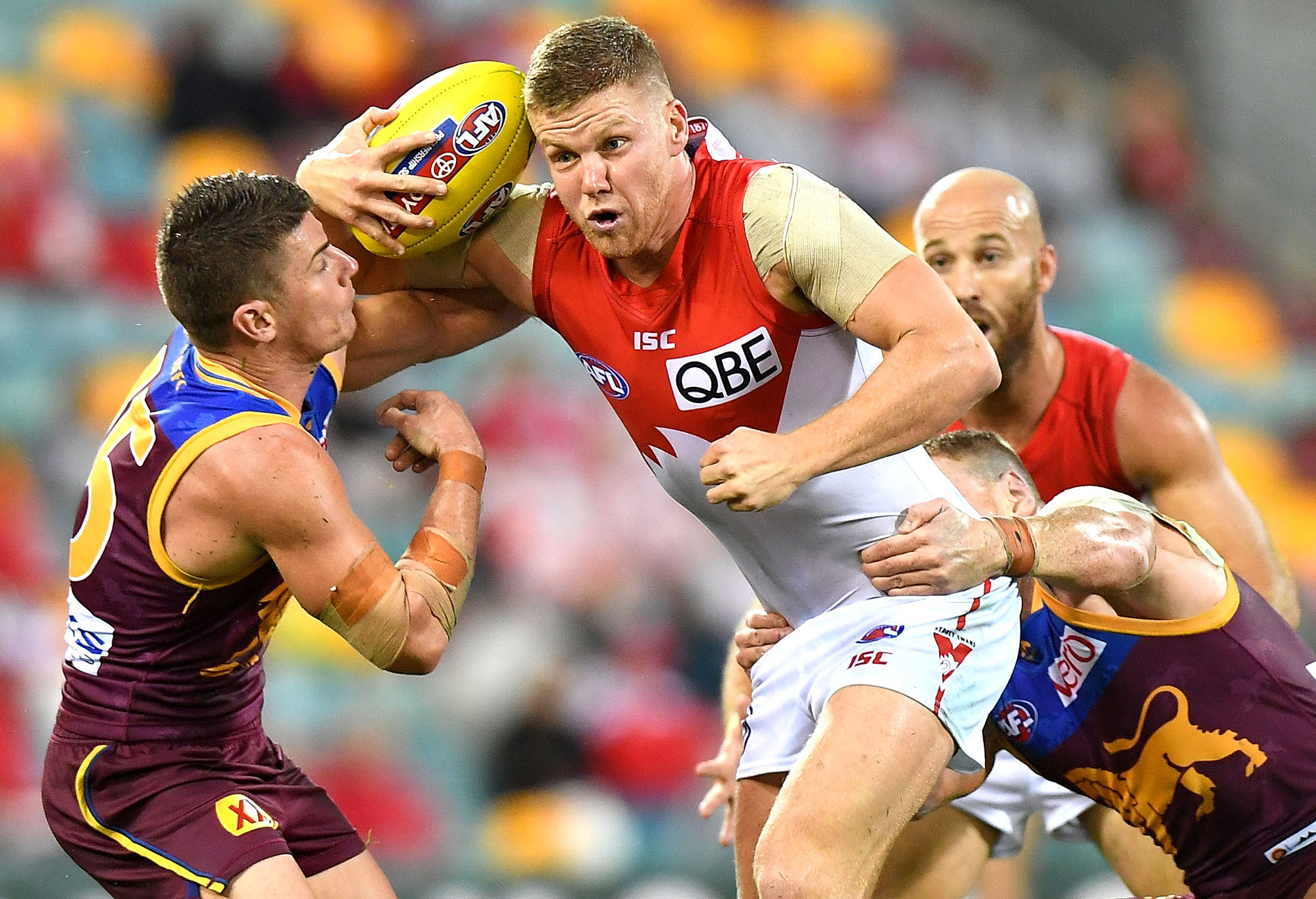
(Photo by Bradley Kanaris/Getty Images)
What’s probably more likely is that the Suns will simply need to accept that their prime-age group is going to collapse, and work out the best way to deal with this.
Is it to hold anyone who may want to leave to their contracts next year and then see them go when those contacts end, or is it to cut their losses now in the hopes of stopping the culture rot at the club?
There’s no denying that for the players to have spent this year knowing that their captain isn’t willing to sign on for the future is damaging to the culture of the club.
Can the Suns afford to then potentially spend all of 2019 enduring speculation over May or Swallow (or Martin or Wright)? Or in 2020 with Will Brodie or Jack Scrimshaw?
If, as is likely, the Suns aren’t able to land some prime-age stars this offseason, then the healthiest move for the club might be to go to each player and say you’re either in or you’re out – if you’re in, you commit. If you’re out, you leave this year.
They probably lose a lot of talent by doing that but to be enduring contract saga after contract saga is like gangrene in the club’s culture. You might need to lose a few fingers, or more, to save your life.
They’ll certainly lose Aaron Hall this year – though from the sounds of it he won’t be particular missed, and probably isn’t going to draw much of a return at the trade table.
If they go down this route then the Suns will have a lot of draft picks coming in this year and next, and it’ll be crucial to find players of good character – those who are going to commit, and make the club a good place to be aroud.
We’ll talk more about that in the draft section, but I believe regardless of which direction the Suns go in this year at the trade table, they must do everything they can to draft Sam Walsh.
When we talked about Walsh vs Jack Lukosius yesterday regarding Carlton, I said it was a question with two right answers – that’s true for the Blues, it’s not true for the Suns.
Yes Lukosius might be a generational talent, but Gold Coast simply can’t pass up the chance to recruit someone with the leadership, charisma and character of Walsh.
For a club in an expansion market, South Australian Lukosius has ‘flight risk’ written all over him. Walsh, by all reports, is anything but.
Carlton are still making their decision on who to take at pick 1, if they keep it, but if I were Gold Coast I would be jumping in with an offer right away.
Offer Carlton pick 2 plus the West Coast Eagle’s first-round pick (acquired last year, pick 17 on current ladder) – they will find it hard to say no.
The trade could alternatively Will Brodie and/or Jack Scrimshaw as Carlton are said to want both, or picks acquried in exchange for sending Steven May or David Swallow home.
For the Blues that would mean they get Lukosius who they might well want to take at pick 1 anyway, plus the chance to bring in another quality player in the top 20 (or Brodie/Scrimshaw).
For the Suns it means they get the kid who they simply must get – probably overpaying a little do so, but currency is the one thing that’s not a problem for them. Win-win.
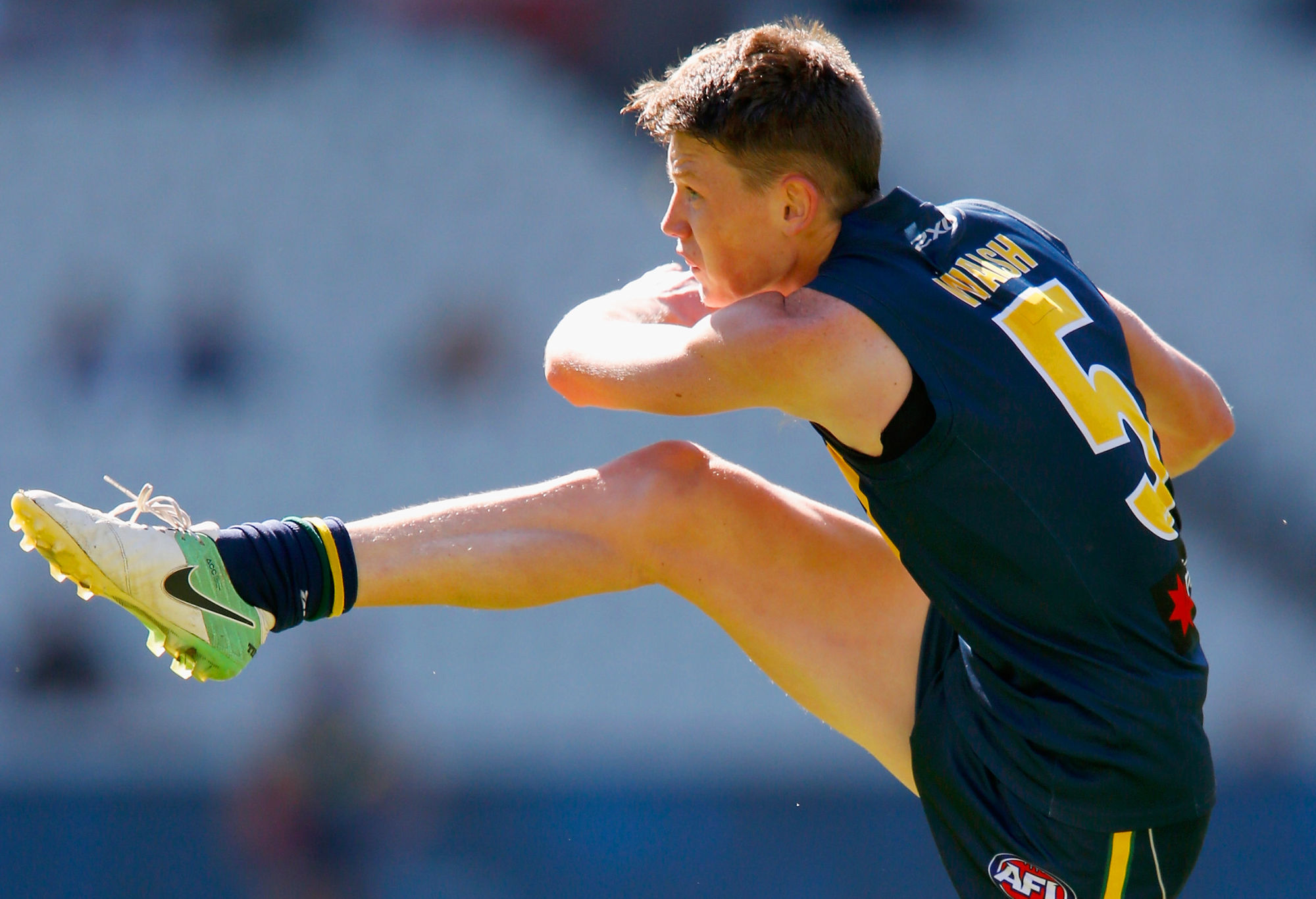
Sam Walsh. (Photo by Darrian Traynor/AFL Media/Getty Images)
Draft
Gold Coast have pick 2 this year and will have West Coast’s first-round pick, wherever it may fall, in the first round also.
They’ll presumably get pick 3 as compensation for Tom Lynch, though could wind up with Richmond’s first pick if they decide to force a trade instead.
They won’t have their own second-rounder, but they will have Essendon and Geelong’s second-rounders, obtained in the trades for Adam Saad and Gary Ablett last year.
They’ll have Fremantle’s third-rounder via the Brandon Matera trade, while their fourth-rounder is at Geelong as part of the Ablett deal.
They’re also likely to have a priority pick handed to them by the AFL – probably pick 20, but possibly pick 12.
And they might also get priority access to two mature-age players, as Carlton are also in the mix for.
We’ve already talked about Sam Walsh and the importance of doing what it takes to get him – fingers crossed for the Suns that they find a way to do so.
They’ll still have pick 3 after that – unless they spin it off in the deal I’ve suggested for Dan Hannebery et al – and it’s an interesting question of what to do there.
Personally, I’d be reaching out to fellow Queenslanders the Bribsane Lions and seeing if a deal can be struck to bring both of the King boys up north.
If the Suns have secured a midfielder in Walsh with their first pick then a tall at their next selection in the form of either Max or Ben King makes sense.
They could then have a handshake deal with Brisbane that the Lions will take whichever of the King twins the Suns pass on.
This works well for both clubs: the twins will have more reason to stay in Queensland long term if they move there together, and both sides could use a young tall forward.
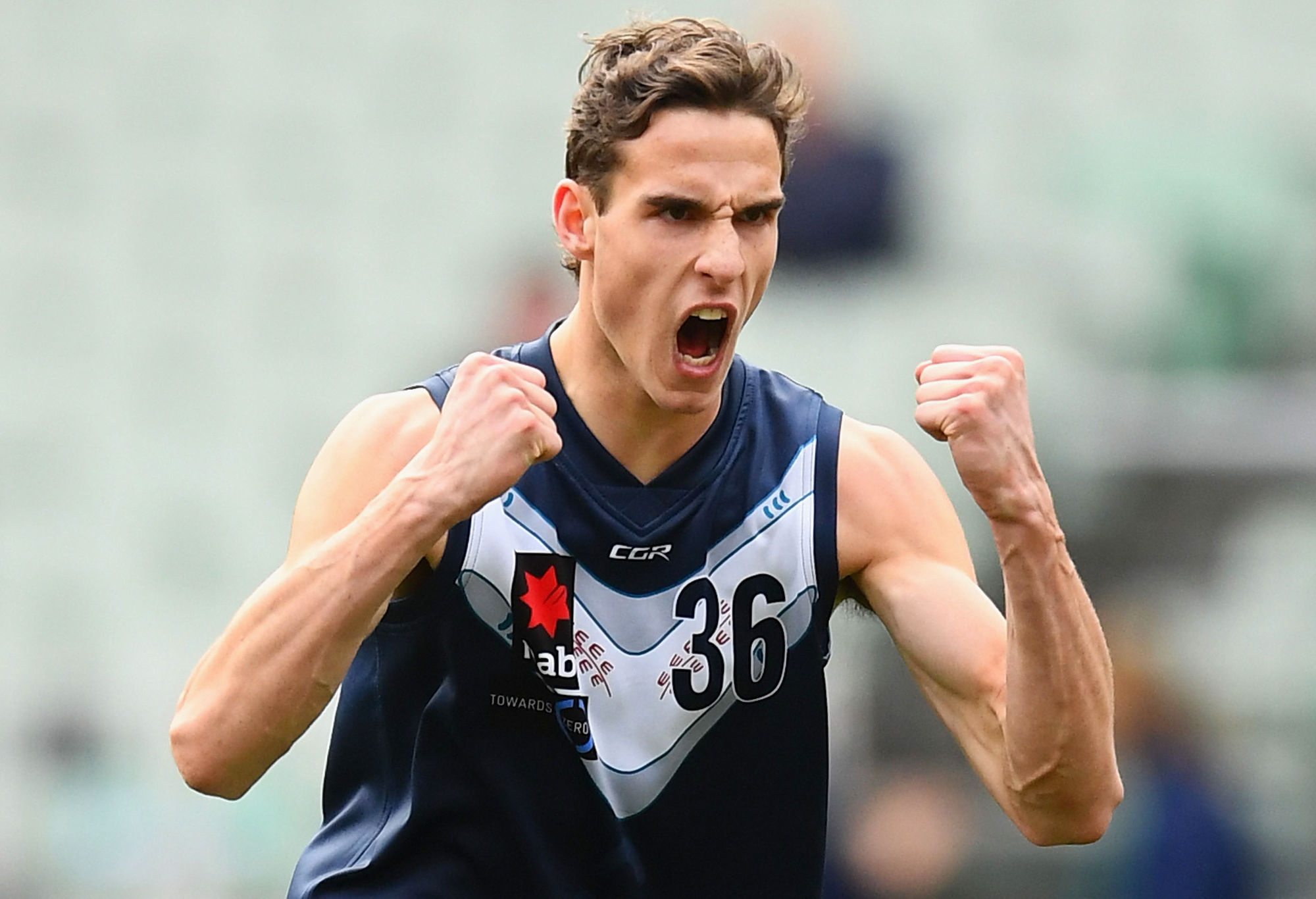
Ben King. (Photo by Quinn Rooney/Getty Images)
If the Suns don’t manage to land Walsh and he goes to Carlton at pick 1, they’ll presumably enter the draft with picks 2 and 3 after that.
In this scenario it might be wise to go tandem on a pair of players with a pre-existing relationship in the hopes this makes them more likely to settle in well and stay at the club.
The King twins would be an obvious choice but they could also go for Jack Lukosius and Izak Rankine, who in addition to being South Australian teammates are also both students at Henley High.
Regarding later picks, the Suns really do need talent of every kind, so I’d say their focus should be less on finding specific positions and more on targetting the players who will best contribute to the development of a new and stronger culture.
I mentioned both of these players regarding Carlton yesterday, but I’ll mention then again – Luke Valente and Ned McHenry should both be on Gold Coast’s radar in this regard.
My advice for most clubs when they draft is to ask what a player will look like in five or ten years time – this is not my advice for the Suns, because if that’s all they consider then those players will wind up wearing someone else’s colours.
Instead the Suns simply have to be short-sighted for now. They have to think about what things are going to look like next year – who can they bring in that’s going to be ready to contribute to the building of a strong, new culture from day 1?
With regards to their potential mature-age priority access, they’ve been linked to Marlion Pickett in the WAFL, and I think they’d do well also to target former Fremantle defender Sam Collins.
What I said last year
“The key to Gold Coast’s future is to re-sign Tom J Lynch, and the likely path to doing that is to make immediate change that gives him confidence the club is on the right track.
“That starts with hiring the right senior coach and likely involves some change among the assistant coaches too.
“This is an appointment Gold Coast simply cannot afford to get wrong… If Lynch leaves, I’d be surprised to seem them do anything of significance before the mid-2020s at best.”
Outlook
Well, the Suns didn’t re-sign Lynch – and in all fairness to them, I think even when I wrote that 12 months ago, any chance of him staying at the club was probably already out the window.
As a result their prime-age group is on the verge of collapse and it’s clear that culture rot has set deeply into the club.
To be fair to the Suns: this isn’t really their fault. I think the majority of their problems stem from the absolute hack job the AFL did in rushing to get them into the league.
The Gold Coast originals were working and training out of portables still for years after the club had been established, and only recently have been able to starting using facilities of good quality.
Poor decisions were probably also made in terms of which mature players the Suns targetted to be the foundation of their club, and the choice to bring in an untried coach like Guy McKenna rather than a veteran like Kevin Sheedy.
Add to that the fact that the Gold Coast is just a much harder place to attract top class professionals to than Sydney, and it’s not hard to see why they’ve struggled.
You might as well dump 30 inner-city IT workers into the middle of the desert, give them a bundle of sticks and ask them to build a skyscraper. There’s just no fathomable way that it was ever going to be a success.
Now the Suns do have elite facilities, they have a greater quality of administration, and while Stuart Dew may not be a veteran coach, he comes with a huge amount of experience and feels like the right man for the job.
Unfortunately by the time all of these things arrived, culture rot had already set in at the club, and the biggest challenge facing them is to stop this in its tracks.
To do this with the most immediate results, and ideal offseason for the Suns would be to turn picks 2 and 17 in to pick 1 and draft Sam Walsh, then send pick 3 to Sydney for Dan Hannebery, Jake Lloyd and Jarrad McVeigh.
Use the priority pick and other second-round picks to draft more kids of good character like Luke Valente and Ned McHenry, and possibly also sign another veteran with premiership experience like Paul Puopolo, Bachar Houli or Shaun Grigg.
Let any players who want out see that with these new additions, there’s a genuine chance of making the club a competitive one sooner rather than later, and more importantly it can be both a fun and constructive place to be.
Realistically speaking this probably won’t happen, with the biggest hurdle to jump being the odds of convincing Lloyd and Hannebery to come to the club.
Even with the Stuart Dew factor, players just don’t really want to come to Gold Coast, to the point where there’s even been talk that players and their agents are doing everything possible to avoid it.
CEO Mark Evans’ response to these rumours was typically combative.
“If there are people out there, managers who are prepared to get up on radio and say don’t go to the Gold Coast, we’ll have them in court as quick as we can,” said Evans.
“I can guarantee you most kids want to start their career, and if you’re a top draft pick, draft hopeful, you’re going to go to one of the bottom four or five clubs.
“The only thing I can think where this might have come from, is there are some kids and some families that have a preference not to travel interstate. But I’ve yet to hear someone say directly to me, ‘don’t come to the Gold Coast’.
“Tell them to get on the radio and put their balls on the line on radio, and then I’ll smash them in the court.”
Nice one Mark. ‘Come say that to my face so I can take you to court over it.’ Really makes you seem like a sane, rational administrator who definitely lives in reality.
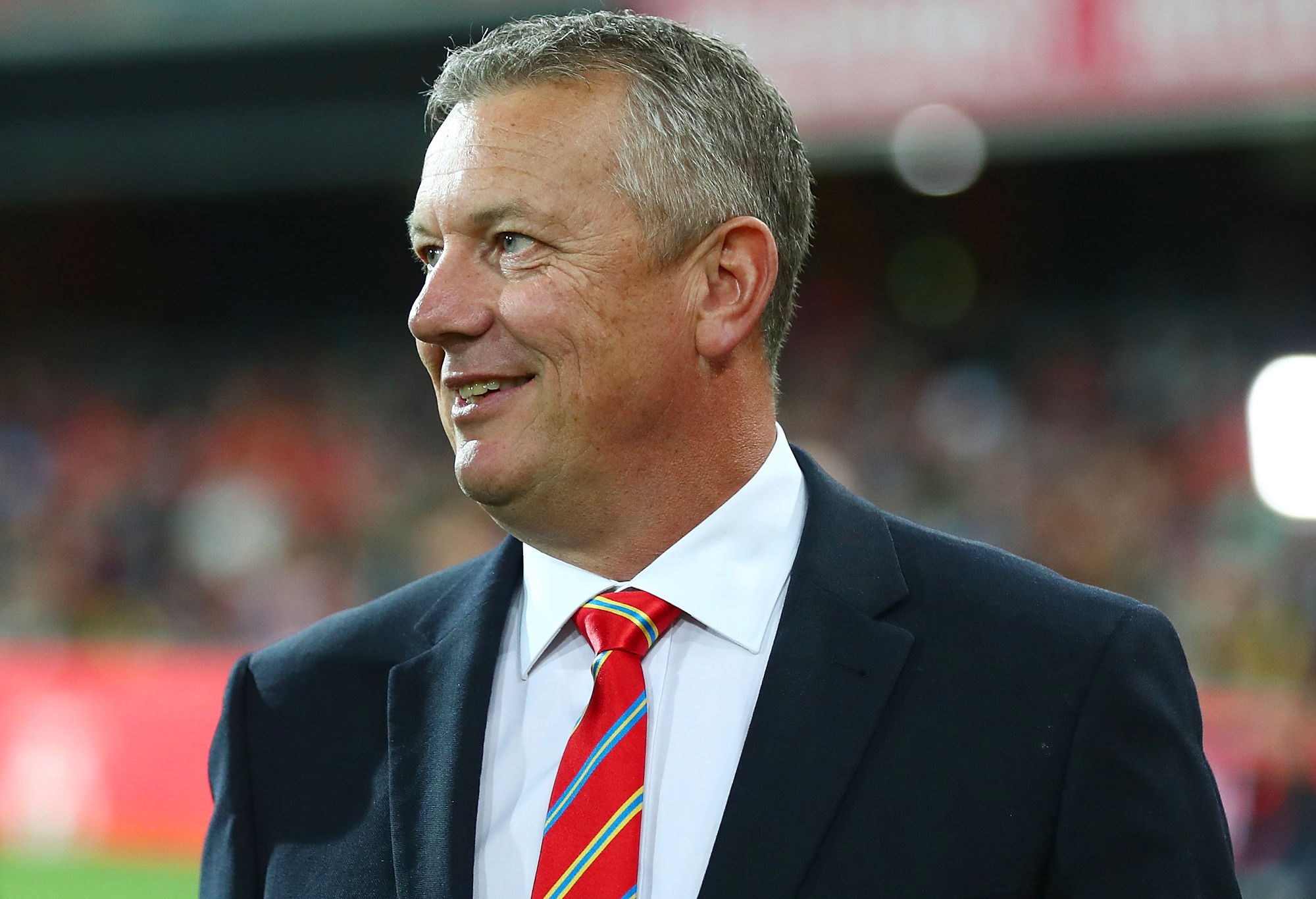
Mark Evans. (Photo by Chris Hyde/Getty Images)
More realistically I suspect the Suns are going to have to make do with taking picks to the draft and investing as best they can in players who are going to commit to building something wortwhile at the Suns.
The big question facing them here is do they cut their losses with players on the current list who may already want out, or keep them around at the risk of their lack of commitment infecting the new blood they acquire at the draft?
Both of these courses of action are poor ones, but if it were me running the show I’d probably go the former, and simply accept that things are going get worse before they get better.
All things considered, the Suns do have some reasons to be optimistic about the future: they’ve got great facilities now, Stuart Dew seems to have been a good pick, and they’ve got plenty of draft currency to invest.
However, if they don’t find a way to stop the rot, they won’t survive in the AFL.





























































































